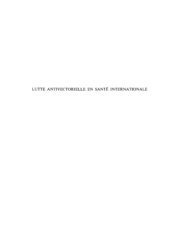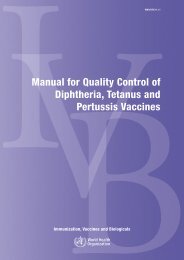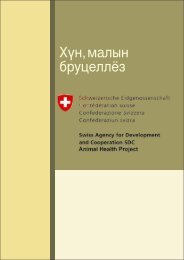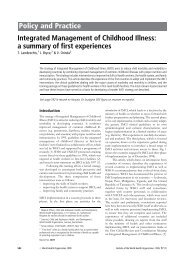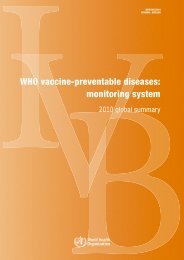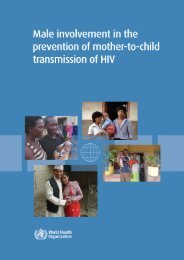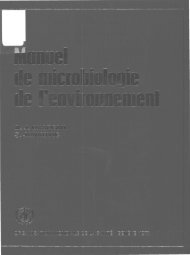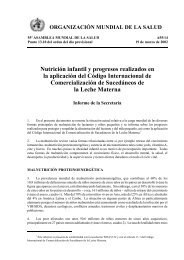Regulatory Situation of Herbal Medicines A worldwide Review
Regulatory Situation of Herbal Medicines A worldwide Review
Regulatory Situation of Herbal Medicines A worldwide Review
You also want an ePaper? Increase the reach of your titles
YUMPU automatically turns print PDFs into web optimized ePapers that Google loves.
WHO/TRM/98.1page 25chemical identification method, check for impurities, assay, region <strong>of</strong> origin, and information on the label <strong>of</strong> thecrude drug. The delivery, sale, storage, <strong>of</strong>fer for sale or the sale <strong>of</strong> imported crude drugs that have not beenregistered and approved by the Minister <strong>of</strong> Health is prohibited [112].The import and the distribution <strong>of</strong> imported crude drugs and licensed traditional drugs have been regulated inspecific guidelines <strong>of</strong> 2 November 1983 [113]. In principle, foreign traditional drugs are not permitted to beimported into Indonesia, except in the case <strong>of</strong> a licence being granted. After obtaining the approval, it isallowed for one year to import the traditional drug as a finished drug from the country <strong>of</strong> origin, the packagingbeing done in Indonesia. During the following one to two years, the holder <strong>of</strong> the licence must already haveproduced these "foreign" traditional drugs in Indonesia using the imported crude drug as raw material. Theimported crude drug has then to be substituted by an Indonesian crude drug, and the respective plants have tobe cultivated in Indonesia. After this, the import <strong>of</strong> the traditional drug, in the form <strong>of</strong> the finished product, is notallowed anymore. Finally, a certificate for marketing is granted after a thorough examination by the NationalQuality Control Laboratory <strong>of</strong> Drug and Food [113]. A new decision <strong>of</strong> the Director General <strong>of</strong> Drugs and FoodControl was issued in 1984 describing more detailed provisions for the registration <strong>of</strong> imported crude drugs[114].To protect the public, the Ministry <strong>of</strong> Health published a Decree dated 31 July 1992 to prohibit the productionand distribution <strong>of</strong> traditional drugs used intravaginally as suppositories or as eye drops. Those products werewithdrawn from the market within a period <strong>of</strong> two months [115]. Drugs or traditional drugs containing morethan 1% ethanol have to indicate the ethanol content on the label [116]. A special decree regulates traditionaldrugs in capsules or tablets [117,118]. These products have to be manufactured under control <strong>of</strong> a pharmacistin accordance with special requirements on stability, extraction liquid and extraction conditions such astemperature and method <strong>of</strong> drying.Besides the "Indonesian Farmacopea", the Directorate General <strong>of</strong> Drugs and Food Control has also publishedsix volumes <strong>of</strong> the "Materia Medika Indonesia". These publications discuss the formal requirements for crudedrugs and give further information which might be needed e.g., local name, section microscopic drawing,crude drug powder and a crude drug colour picture. The Materia Medika Indonesia (Volumes I to VI) contains350 crude drug monographs and is used as the formal quality requirement book for crude drugs in Indonesia[111].LabellingSince 1985, special guidelines on labelling <strong>of</strong> traditional drugs have been issued [119]. It is required that thelabelling states the correct information, that the label is clear and easy to read and that the explanation <strong>of</strong>traditional drugs is written in the Indonesian language and in Latin letters. Traditional drugs are characterizedby a special emblem, e.g., a leaf. The registration number has to be included on the label together with thename and address <strong>of</strong> the company, composition, indication, method <strong>of</strong> use and dosage, duration <strong>of</strong>administration, warnings, contra-indications, storage, expiry date and production code. Similar information isrequired for the package leaflet.Good Manufacturing PracticesA Decree <strong>of</strong> the Minister <strong>of</strong> Health dated 30 October 1991 regulates Good Manufacturing Practices <strong>of</strong>Traditional Drugs (GMPTD) [120]. These rules cover the aspects related to the production <strong>of</strong> traditional drugswith the objective to guarantee that the product always fulfils the requirements. There are generalrequirements regarding the employees, the responsible persons in the technical field, training in GMPTD, thepremises, the area and equipment (machinery and laboratory). Processing and packing also must be carriedout with special methods. A periodic self-inspection has to be made and everything has to be documentedclearly. If there are concerns regarding safety or quality, these have to be checked and, if no longer adequate,the product has to be withdrawn from the market.In 1993, the Directorate General <strong>of</strong> Drugs and Food Control published an English translation <strong>of</strong> all theregulations relevant for traditional drugs [121]. This book was intended to provide guidance for manufacturers,distributors or institutes, on traditional drugs and crude drugs with respect to their production and distributionso as to ensure products <strong>of</strong> good quality.



